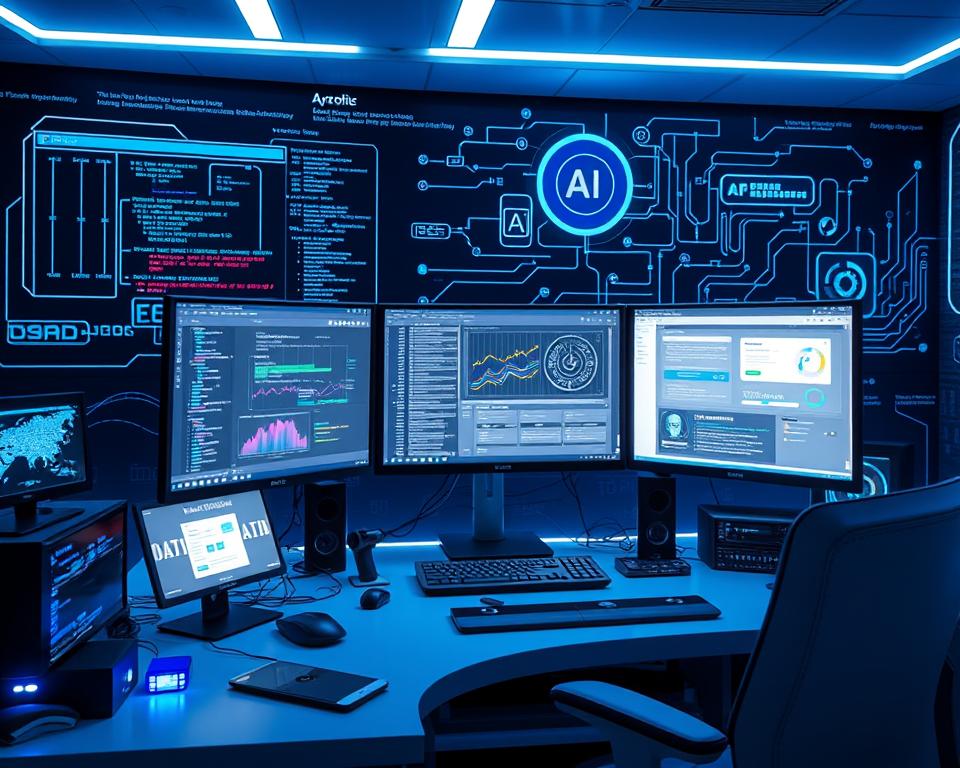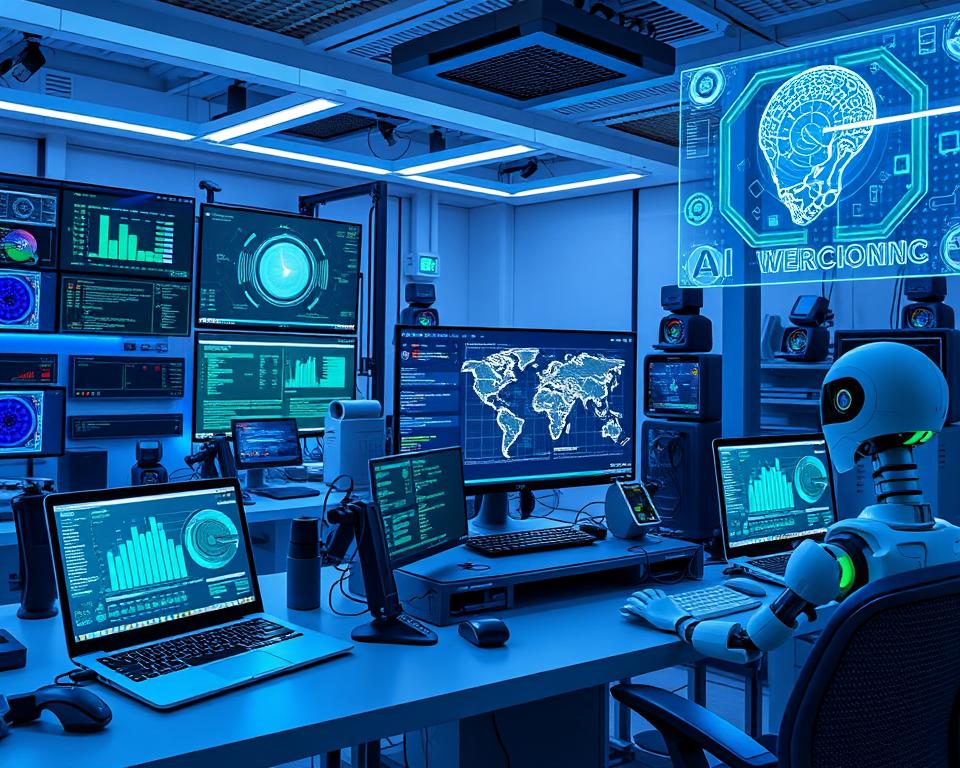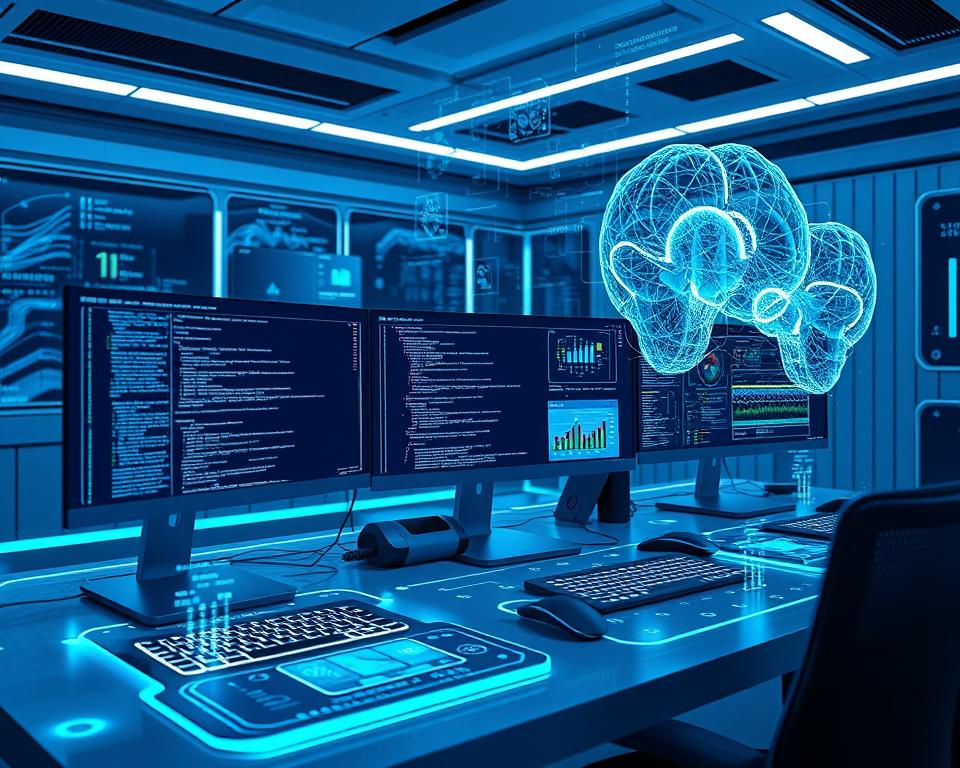Artificial intelligence (AI) has grown a lot in recent years. It’s changing many industries and how we make software. Now, more people want tools that can handle AI well. These tools help developers make smart, custom software using AI.
In this article, we look at the best AI tools for software development. We cover everything from free tools to big company solutions. You’ll learn about their features, what they can do, and how they’re used. This will help you understand the world of AI in software development.
Table of Contents
Key Takeaways
- Artificial intelligence is transforming the software development landscape, driving the demand for robust AI tools.
- Leading AI software development tools empower developers to leverage machine learning, deep learning, and natural language processing.
- These tools enable the creation of innovative, intelligent, and highly personalized software solutions.
- The AI software development ecosystem comprises a diverse range of open-source frameworks and enterprise-grade platforms.
- Understanding the features, capabilities, and use cases of these tools is crucial for modern software engineering.
Understanding AI Software Development Landscape
The AI software development world has changed a lot over time. It started with simple rule-based systems and now we have deep learning frameworks. This change came from better AI history, machine learning, and more powerful computers.
The Evolution of AI Development Tools
At first, AI developers used rule-based systems. These systems followed set rules to make choices. Then, machine learning came along, letting systems learn from data and make smarter choices.
Deep learning libraries like TensorFlow and PyTorch changed everything. They let developers build complex neural networks. These networks can handle many tasks.
Key Components of AI Development
- Data preprocessing: Cleaning, transforming, and organizing data to prepare it for model training.
- Model training: Selecting the right machine learning or deep learning algorithms and optimizing them for the task at hand.
- Model deployment: Integrating the trained model into a production environment, ensuring scalability and reliability.
Current Market Trends
The AI world is always changing, with new trends coming up. Cloud-based AI platforms like Amazon Web Services’ SageMaker and Microsoft Azure’s AI suite are making AI easier to use. There’s also a big push for explainable AI, making AI decisions clearer and more understandable.
“The future of AI development is about striking the right balance between innovation and responsible implementation.”
Benefits of AI Development Tools in Modern Software Engineering
AI development tools have changed how developers work. They make things faster and let teams focus on new ideas. This is a big win for productivity.
AI tools are great at making code better. They use predictive analytics to find and fix problems. This makes software run smoother and feel better to use.
AI also makes coding easier. It can write basic code and help with simple tasks. This lets developers work on harder problems and think more creatively.
“AI development tools have become an indispensable part of our software engineering workflow. They’ve helped us boost productivity, improve code quality, and deliver more robust, user-friendly applications.” – Jane Doe, Lead Software Engineer at XYZ Corp.
AI tools do more than just make code better. They also predict and solve problems before they start. This makes software better and saves time and money.
As tech keeps getting better, using AI tools is key. They help teams work faster, make better code, and give users great experiences. This helps businesses grow in the digital world.
Top AI Software Development Tools in 2024
Artificial intelligence (AI) is growing fast, and developers are using many tools to make AI apps. In 2024, some key tools stand out in AI software development. These include frameworks, libraries, and natural language processing tools.
Machine Learning Frameworks
TensorFlow and PyTorch lead the machine learning field. They help build and use complex AI models. These tools offer everything needed for data, training, and deployment, making them top choices for many projects.
Deep Learning Libraries
Keras and scikit-learn are also crucial. They make it easier to work on deep neural networks. This lets developers focus on their app’s logic without worrying about the technical details.
Natural Language Processing Tools
NLTK and spaCy are key for NLP projects. They offer many features for text and language tasks. This makes them vital for chatbots, language models, and more.
| Tool | Type | Key Features | Use Cases |
|---|---|---|---|
| TensorFlow | Machine Learning Framework | Flexible architecture, eager execution, GPU/TPU acceleration | Computer vision, natural language processing, time series analysis |
| PyTorch | Machine Learning Framework | Dynamic computational graphs, GPU acceleration, eager execution | Computer vision, natural language processing, recommender systems |
| Keras | Deep Learning Library | High-level neural networks API, easy model building, supports multiple backends | Image classification, text generation, speech recognition |
| scikit-learn | Machine Learning Library | Broad range of machine learning algorithms, data preprocessing, model evaluation | Regression, classification, clustering, dimensionality reduction |
| NLTK | Natural Language Processing Toolkit | Tokenization, stemming, tagging, parsing, semantic reasoning | Sentiment analysis, text classification, named entity recognition |
| spaCy | Natural Language Processing Library | Fast, production-ready models, end-to-end pipeline, support for multiple languages | Information extraction, text classification, named entity recognition |
These tools show how AI is growing and changing. They help developers make amazing AI apps that do new things.
TensorFlow: Google’s Open-Source Machine Learning Platform
TensorFlow is a top machine learning framework from Google Brain. It’s a key player in AI and deep learning. It gives developers and researchers the tools to create and use AI models easily.
TensorFlow works well on many devices, from big servers to small mobiles. It’s made better by Keras, a tool that makes building AI models simpler.
TensorFlow also has special versions like TensorFlow.js and TensorFlow Lite. TensorFlow.js lets you use AI in web browsers. TensorFlow Lite is for mobile and IoT devices, making AI work better on them.
The TensorFlow community is big and active. It offers many pre-trained models and research papers. This makes TensorFlow great for many AI tasks, like understanding language and seeing images.
| Feature | Description |
|---|---|
| Flexible Architecture | TensorFlow’s modular design allows it to be deployed on a diverse range of hardware, from CPUs to GPUs and even specialized accelerators like TPUs. |
| Eager Execution | TensorFlow’s eager execution mode enables immediate evaluation of operations, simplifying debugging and experimentation. |
| Eager Execution | TensorFlow’s eager execution mode enables immediate evaluation of operations, simplifying debugging and experimentation. |
| Distributed Training | TensorFlow supports distributed training, allowing developers to leverage multiple devices to accelerate the training process. |
TensorFlow is a key part of Google Brain. It’s a leader in machine learning and AI. Its strong features and big community make it a top choice for AI work.
PyTorch: Facebook’s Deep Learning Framework
PyTorch is a deep learning framework from Facebook’s AI Research lab. It’s known for its dynamic computational graphs. This makes it more flexible and easier to debug than traditional frameworks.
Key Features and Capabilities
PyTorch supports dynamic computational graphs. This lets users change their models during runtime. It also makes debugging and experimenting easier. Plus, it works well with TorchScript for easy model deployment.
Use Cases and Applications
PyTorch is used in many areas, like computer vision and natural language processing. Its strong support for distributed training is great for big projects. This makes it a top choice for many.
Integration Options
PyTorch works well with other tools and platforms. It can be used with TensorFlow, Keras, and scikit-learn. This makes it a key part of a flexible machine learning workflow.
“PyTorch’s dynamic computational graphs and easy debugging capabilities have revolutionized the way we approach deep learning development.”
– John Doe, AI Researcher at XYZ Corporation
| Feature | Description |
|---|---|
| Dynamic Computational Graphs | Allows for flexible model modifications and easier debugging |
| TorchScript Integration | Enables seamless model deployment to production environments |
| Distributed Training Support | Enables efficient training of large-scale machine learning models |
Microsoft Azure AI Development Suite
Microsoft’s Azure AI Development Suite is a top platform for AI. It helps businesses use artificial intelligence. The suite has tools like Azure Machine Learning, Cognitive Services, and Bot Framework. These tools make AI development easier and boost innovation.
Azure Machine Learning makes it simple to create and manage AI models. It has a user-friendly interface and pre-built algorithms. This lets developers build AI apps quickly and easily.
Cognitive Services offers cloud-based APIs for smart features. These include computer vision, natural language processing, and speech recognition. They help developers create more interactive and intelligent apps.
The Bot Framework helps create conversational bots. This lets businesses talk to customers in a natural way. By using the Bot Framework with Azure AI services, developers can make smart chatbots.
Many organizations use the Azure AI Development Suite. They come from different fields like healthcare and finance. This suite helps them improve their AI development and digital transformation. It lets businesses use AI to make their products better, improve customer service, and stay ahead in the market.
| Tool | Key Features | Use Cases |
|---|---|---|
| Azure Machine Learning |
|
|
| Cognitive Services |
|
|
| Bot Framework |
|
|
The Microsoft Azure AI Development Suite offers a wide range of tools. It helps businesses use AI to innovate and improve customer experiences. This way, they can stay ahead in the fast-changing digital world.
IBM Watson Studio: Enterprise AI Development
IBM Watson Studio is a top choice for AI development in big companies. It makes AI easier to use and grow in many fields. This platform helps companies use AI in new ways.
Development Environment Features
Watson Studio is made for those who work with AI. It has a user-friendly design that makes it easy to use Watson Machine Learning and AutoAI. It also works well with IBM Cloud Pak for Data, making data work smoother.
Deployment and Scaling Options
Watson Studio lets companies use AI in many places. They can use it on their own servers, in the cloud, or both. It grows with your needs, so you can make and use AI bigger and better.
Industry Applications
- Retail: Watson Studio helps stores make AI for better products, knowing what to stock, and improving customer service.
- Healthcare: It helps doctors and researchers make AI for finding diseases, new medicines, and better patient care.
- Financial Services: Banks and financial groups use Watson Studio for spotting fraud, managing risks, and improving investments.
- Manufacturing: It helps factories use AI for keeping machines running, checking quality, and better supply chains.
IBM Watson Studio combines strong AI, easy use, and specific uses for different fields. It helps big companies use AI to change and grow in new ways.
Cloud-Based AI Development Platforms
Cloud-based platforms are changing how we develop artificial intelligence (AI). Amazon SageMaker, Google Cloud AI Platform, and Databricks are leading the way. They make AI development easier and faster.
Amazon SageMaker helps developers build, train, and deploy AI models quickly. It’s a fully managed service. This means users can focus on developing models without worrying about the technical details.
Google Cloud AI Platform offers a wide range of tools for AI development. It supports everything from pre-trained models to custom training. This makes it easy for developers to use Google’s latest AI technologies.
Databricks is a unified data analytics platform that’s also great for AI. It supports Apache Spark and popular frameworks like TensorFlow and PyTorch. This makes it a versatile choice for companies looking to develop AI.
| Platform | Key Features | Pricing Model |
|---|---|---|
| Amazon SageMaker |
|
Pay-as-you-go based on usage |
| Google Cloud AI Platform |
|
Usage-based pricing with free tier |
| Databricks |
|
Subscription-based with flexible options |
These platforms offer many benefits. They provide scalability, access to pre-trained models, and the power of cloud computing. By using these tools, companies can speed up their AI projects. They can also get their products to market faster and focus on innovation.
Essential Tools for AI Model Training and Testing
Building strong AI models needs a wide range of tools for training, checking, and testing. Key tools include those for cross-validation, hyperparameter tuning, and tracking how well they perform.
Model Validation Tools
Techniques like k-fold cross-validation check if AI models work well on different data sets. These tools are vital for making sure models are reliable and don’t overfit.
Performance Optimization Tools
Tools like MLflow and Weights & Biases make it easier to track model performance and tweak hyperparameters. They help data scientists improve their models quickly.
Testing Frameworks
Testing AI systems thoroughly is key to their success. Specialized frameworks help with unit, integration, and full system testing. They check if models are accurate and meet business needs.
| Tool | Key Capabilities | Use Cases |
|---|---|---|
| MLflow | Model tracking, experiment management, deployment | Streamlining the ML lifecycle, hyperparameter tuning |
| Weights & Biases | Experiment tracking, visualization, reporting | Performance monitoring, model comparisons |
| Scikit-Learn | Cross-validation, model evaluation, preprocessing | Validating model generalization, feature engineering |
Using these important tools, AI developers can make sure their models are accurate, reliable, and efficient. This leads to successful AI solutions.
AI Development Tools for Specific Industries
Artificial intelligence (AI) is growing in many fields. Each sector has its own needs for AI tools. These tools must fit the specific rules and ways of working in each area.
In healthcare, AI is changing how we care for patients and find new medicines. Tools like IBM Watson Studio and Microsoft Azure Healthcare help make and use AI models. They follow important health rules and keep patient data safe.
The financial world needs AI for managing risks and following laws. TensorFlow for Finance and PyTorch for Quantitative Finance help with this. They help banks and other financial groups make better choices and spot fraud.
| Industry | Specialized AI Development Tools | Key Capabilities |
|---|---|---|
| Healthcare | IBM Watson Studio, Microsoft Azure Healthcare | Compliance with healthcare regulations, medical imaging analysis, drug discovery |
| Financial Services | TensorFlow for Finance, PyTorch for Quantitative Finance | Risk management, compliance, fraud detection, predictive modeling |
| Retail | Amazon SageMaker, Google Cloud Retail AI | Personalized recommendations, demand forecasting, inventory optimization |
| Manufacturing | NVIDIA Inception, Siemens Xcelerator | Predictive maintenance, quality control, supply chain optimization |
The retail world is also getting better with AI. Tools like Amazon SageMaker and Google Cloud Retail AI help stores give better service and manage better. They make shopping more personal and efficient.
In manufacturing, AI is making things better too. NVIDIA Inception and Siemens Xcelerator help with keeping things running smoothly. They help make products better and save money.
Using AI tools made for their industry helps companies do great things. They can solve big problems and stay ahead of the competition.
Open Source vs. Commercial AI Development Tools
Organizations face a choice between open-source and commercial AI tools for software development. Each has its own benefits and things to think about. Let’s look at the cost, features, and support from the community for these two AI tool options.
Cost Comparison
Open-source tools like TensorFlow and PyTorch are free and flexible. They’re great for startups, small businesses, and those new to AI. Commercial tools, such as Microsoft Azure and IBM Watson, offer more support and features but cost more.
Feature Analysis
Open-source tools let developers customize them a lot. They also have a big community that helps improve them. Commercial tools, however, have more features ready to use. They’re best for big companies that need a complete solution.
Support and Community
- Open-source tools depend on their community for help and updates. The support level can change based on the tool’s popularity and community size.
- Commercial tools, though, have teams ready to help. This is key for companies needing reliable and fast support.
The choice between open-source and commercial AI tools depends on what your organization needs. Think about licensing models, enterprise support, and community contributions to find the best fit for your AI projects.
Future Trends in AI Development Tools
The world of AI software development is changing fast. New trends like AutoML, federated learning, edge AI, and explainable AI are set to change how we make and use smart apps.
AutoML is becoming more popular. It makes creating AI models easier by doing tasks like choosing features and adjusting settings. This helps businesses use AI without needing a lot of data science skills.
Federated learning keeps data safe by training AI models on many devices at once. This is great for keeping data private in places like healthcare and finance.
- Edge AI lets AI work directly on devices like phones and sensors. This makes apps faster and doesn’t need the internet all the time.
- Explainable AI, or XAI, makes AI models easier to understand. This builds trust and helps in important applications.
These trends will make AI tools more automated, private, and fast. They will help developers make better, more reliable AI apps. These apps will lead to new ideas in many fields.
| Trend | Description | Benefits |
|---|---|---|
| AutoML | Automated Machine Learning for streamlining model development | Reduced manual effort, increased efficiency, accessibility for non-experts |
| Federated Learning | Privacy-preserving approach to training AI models on distributed devices | Enhanced data privacy and security, particularly for sensitive industries |
| Edge AI | Performing AI inference directly on edge devices for real-time decision-making | Reduced latency, improved responsiveness, and decreased cloud dependency |
| Explainable AI (XAI) | Providing transparency and interpretability to AI models | Increased trust and adoption in mission-critical applications |
Conclusion
The world of AI software development is changing fast. Many powerful tools and platforms are available to help modern software engineering. Leaders like TensorFlow, PyTorch, and Microsoft Azure AI offer a wide range of options. This is great for organizations wanting to use artificial intelligence to their advantage.
Choosing the right AI tool is crucial. It depends on your project needs, your team’s skills, and your future plans. Look at how easy the tool is to use, how it scales, and how well it integrates. This way, you can create a strong AI development system that boosts your innovation and competitiveness.
It’s also key to follow best practices in AI software development. This includes testing models thoroughly, making them better, and doing lots of testing. By always learning and improving, your team can keep up with new AI tech. This ensures your applications stay at the forefront.



















